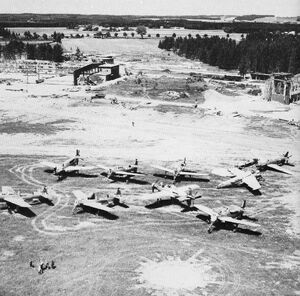The Dornier Do 335 Pfeil ("Arrow") was a World War II heavy fighter built by the Dornier company. The two-seater trainer version was also called Ameisenbär("anteater"). The Pfeil's performance was much better than other twin-engine designs due to its unique "push-pull" layout and the much lower aerodynamic drag of the in-line alignment of the two engines. It was Germany's fastest piston-engined aircraft of World War II.The Luftwaffe was desperate to get the design into operational use, but delays in engine deliveries meant only a handful were delivered before the war ended.
Design and development[]
The origins of the Do 335 trace back to World War I when Claude Dornier designed a number of flying boats featuring remotely driven propellers and later, due to problems with the drive shafts, tandem engines. Tandem engines were used on most of the multi-engine Dornier flying boats that followed, including the highly successful Do J Wal and the gigantic Do X. The remote propeller drive, intended to eliminate parasitic drag from the engine entirely, was tried in the innovative but unsuccessful Do 14, and elongated, tubular drive shafts as later used in the Do 335 saw use in the rear engines of the four-engined, twinned tandem-layout Do 26 flying boat.
There are many advantages to this design over the more traditional system of placing one engine on each wing, the most important being power from two engines with the frontal area (and thus drag) of a single-engine design, allowing for higher performance. It also keeps the weight of the twin powerplants near, or on, the aircraft centerline, increasing the roll rate compared to a traditional twin. In addition, a single engine failure does not lead to asymmetric thrust, and in normal flight there is no net torque so the plane is easy to handle. The choice of a full "four-surface" set of cruciform tail surfaces in the Do 335's rear fuselage design, included a ventral vertical fin–rudder assembly to project downwards from the extreme rear of the fuselage, in order to protect the rear propeller from an accidental ground strike on takeoff. The presence of the rear pusher propeller also mandated the provision for an ejection seat for safe escape from a damaged aircraft, and designing the rear propeller and dorsal fin mounts to use explosive bolts to jettison them before an ejection was attempted — as well as twin canopy jettison levers, one per side, located to either side of the forward cockpit interior just below the sills of the five-panel windscreen's sides, to jettison the canopy from atop the cockpit before ejection.[3]
In 1939, Dornier was busy working on the P.59 high-speed bomber project, which featured the tandem engine layout. In 1940, he commissioned a test aircraft, closely modeled on the airframe of the early versions of the Dornier Do 17 bomber but only 40% of the size of the larger bomber, with no aerodynamic bodies of any sort on the wing panels (the original Do 17 had twin engine nacelles on its wings) and fitted with a retractable tricycle landing gear to validate his concept for turning the rear pusher propeller with an engine located far away from it and using a long tubular driveshaft. This aircraft, the Göppingen Gö 9, showed no unforeseen difficulties with this arrangement, but work on the P.59 was stopped in early 1940 when Hermann Göring ordered the cancellation of all projects which would not be completed within a year or so.
In May 1942, Dornier submitted an updated version with a 1,000 kg (2,200 lb) bombload as the P.231, in response to a requirement for a single seat, Schnellbomber-like high-speed bomber/intruder. P.231 was selected as the winner after beating rival designs from Arado, Junkers, and Blohm & Voss development contract was awarded as the Do 335. In autumn 1942, Dornier was told that the Do 335 was no longer required, and instead a multi-role fighter based on the same general layout would be accepted. This delayed the prototype delivery as it was modified for the new role.

Do-335s on the apron at Oberpfaffenhofen at the war's end, including unfinished two-seat versions[2]
The distinctive use of a nose-mount annular radiator for the forward engine (much like a Jumo 211-powered Ju 88, or Jumo 213-powered Focke-Wulf Fw 190D-9) and a ventral-fuselage mount airscooped radiator installation for cooling the rear engine (appearing like that on a P-51 Mustang), when fitted with DB 603A engines delivering 1,750 PS (1,287 kW, 1,726 hp) at takeoff — the largest displacement (at 44.52 litres) inverted V12 aircraft engine design mass-produced during the Third Reich's existence — the Do 335 V1 first prototype, bearing the Stammkennzeichen (factory radio code) of CP+UA, flew on 26 October 1943 under the control of Flugkapitän Hans Dieterle, a regular Heinkel test pilot and later primary Dornier test pilot. However, several problems during the initial flight of the Do 335 would continue to plague the aircraft through most of its short history. Issues were found with the weak landing gear and with the maingear's wheel well doors, resulting in them being removed for the remainder of the V1's test flights. The Do 335 V1 made 27 flights, flown by three different pilots. During these test flights the V2 (W.Nr 230002), Stammkennzeichen CP+UB was completed and made its first flight on 31 December 1943, again under the control of Dieterle. New to the V2 were upgraded DB 603A-2 engines, and several refinements learned from the test flights of the V1 as well as further windtunnel testing. On 20 January 1944, the Do 335 V3 (W.Nr. 230004), Stammkennzeichen CP+UC was completed and flown for its first time by Werner Altrogge. The V3 was powered by the new pre-production DB 603G-0 engines which could produce 1,900 PS (1,400 kW) at take-off and featured a slightly redesigned canopy which included twin rear-view mirrors in blisters, one in each of two matching side panels of the well-framed, eleven-panel main canopy's openable section. Following the flights of the V3, in mid January 1944, RLM ordered five more prototypes (V21–V25), to be built as night fighters. By this time more than 60 hours of flight time had been put on the Do 335 and reports showed it to be a good handling, but more importantly, very fast aircraft, described by Generalfeldmarschall Erhard Milch himself as "...holding its own in speed and altitude with the P-38 and it does not suffer from engine reliability issues". Thus the Do 335 was scheduled to begin mass construction, with the initial order of 120 preproduction aircraft to be manufactured by DWF (Dornier-Werke Friedrichshafen) to be completed no later than March 1946. This number included a number of bombers, destroyers (heavy fighters), and several yet to be developed variants. At the same time, DWM (Dornier-Werke München) was scheduled to build over 2000 Do 335s in various models, due for delivery in March 1946 as well.
On 23 May 1944, Hitler, as part of the developing Jägernotprogramm directive which took effect on 3 July, ordered maximum priority to be given to Do 335 production. The main production line was intended to be at Manzell, but a bombing raid in March destroyed the tooling and forced Dornier to set up a new line at Oberpfaffenhofen. The decision was made, along with the rapid shut-down of many other military aircraft development programs, to cancel the Heinkel He 219 night fighter, which also used the DB 603 engines, and use its production facilities for the Do 335 as well. However, Ernst Heinkel managed to delay, and eventually ignore, its implementation, continuing to produce examples of the He 219A.
At least 16 prototype Do 335s were known to have flown (V1–V12, W.Nr 230001-230012 and Muster-series prototypes M13–M17, W.Nr 230013-230017) on a number of DB603 engine subtypes including the DB 603A, A-2, G-0, E and E-1. The first preproduction Do 335 (A-0s) starting with W.Nr 240101, Stammkennzeichen VG+PG, were delivered in July 1944. Approximately 22 preproduction aircraft were thought to have been completed and flown before the end of the war, including approximately 11 A-0s converted to A-11s for training purposes. One such aircraft was transferred the Royal Aircraft Establishment in Farnborough, and later crashed onto a local school.
Flight tests[]

Do 335 tested in the USA, and today the only surviving example[2]
The first 10 Do 335 A-0s were delivered for testing in May. By late 1944, the Do 335 A-1 was on the production line. This was similar to the A-0 but with the uprated DB 603 E-1 engines and two underwing hardpoints for additional bombs, drop tanks or guns. It was capable of a maximum speed of 763 km/h (474 mph) at 6,500 m (21,300 ft) with MW 50 boost, or 686 km/h (426 mph) without boost, and able to climb to 8,000 m (26,250 ft) in under 15 minutes. Even with one engine out, it could reach about 563 km/h (350 mph).
Delivery commenced in January 1945. When the United States Army overran the Oberpfaffenhofen factory in late April 1945, only 11 Do 335 A-1 single-seat fighter-bombersand two Do 335 A-12 trainers had been completed.
French ace Pierre Clostermann claimed the first Allied combat encounter with a Pfeil in April 1945. In his book The Big Show (pp. 273–274) he describes leading a flight of four Hawker Tempests from No. 3 Squadron RAF over northern Germany, when he intercepted a lone Do 335 flying at maximum speed at treetop level. Detecting the British aircraft, the German pilot reversed course to evade. Despite the Tempest's considerable low altitude speed, the Royal Air Force fighters were not able to catch up or even get into firing position.
Variants[]
Dornier Pfeil
- Built
- Do 335 A-0 : 10 pre-production aircraft.
- Do 335 A-1 : Single-seat fighter-bomber aircraft.
- Proposed
- Do 335 A-2: single-seat fighter-bomber aircraft with new weapon aiming systems, later proposed longer wing and updated DB603L engines.
- Do 335 A-3: single-seat reconnaissance aircraft built from A-1 aircraft, later proposed with longer wing.
- Do 335 A-4: single-seat reconnaissance aircraft with smaller cameras than the A-3
- Do 335 A-5: single-seat night fighter aircraft, later night and bad weather fighter with enlarged wing and DB603L engines.
- Do 335 A-6: two-seat night fighter aircraft, with completely separate second cockpit located above and behind the original.
- Do 335 A-7: A-6 with longer wing.
- Do 335 A-8: A-4 fitted with longer wing.
- Do 335 A-9: A-4 fitted with longer wing, DB603L engines and pressurized cockpit.
- Do 335 B-1: abandoned in development.
- Do 335 B-2: single-seat destroyer aircraft. Fitted with 2 additional MK 103 in the wings and two 300 litre (80 US gal) drop tanks.
- Do 335 B-3: updated B-1 but with longer wing.
- Do 335 B-4: update of the B-1 with longer wing, DB603L engine.
- Do 335 B-6: night fighter.
- Do 335 B-12: dual-seat trainer version for the B-series aircraft.
- Do 435: a Do 335 with the redesigned, longer wing. Allied intelligence reports from early May 1945 make a report of a spotted Do 435 at the Dornier factory airfield at Lowenthal.
- Do 535: actually the He 535, once the Dornier P254 design was handed over to Heinkel in October 1944; fitted with jet engine in place of rear piston engine
- Do 635: long-range reconnaissance version. Also called Junkers Ju 635 or Do 335Z. Mock up only.
- Do P 256: turbojet nightfighter version, with two podded HeS 011 turbojet engines, based on Do 335 airframe.
Sources[]
| ||||||||||||||

